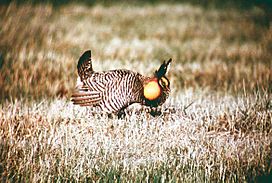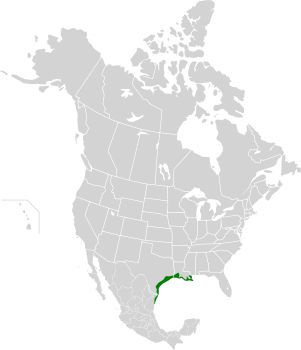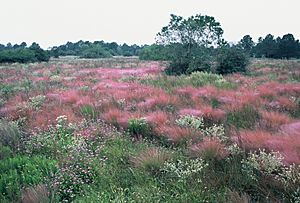Western Gulf coastal grasslands facts for kids
Quick facts for kids Western Gulf coastal grasslandsTamaulipan pastizal |
|
|---|---|
 |
|
 |
|
| Ecology | |
| Realm | Nearctic |
| Biome | Tropical and subtropical grasslands, savannas, and shrublands |
| Borders |
List
|
| Bird species | 335 |
| Mammal species | 75 |
| Geography | |
| Area | 77,425 km2 (29,894 sq mi) |
| Countries | Mexico and United States |
| States | Louisiana, Tamaulipas and Texas |
| Conservation | |
| Habitat loss | 48.734% |
| Protected | 10.31% |
The Western Gulf coastal grasslands are a special natural area. It is a type of grassland found in the southern United States and northeastern Mexico. This area is called an ecoregion, which is a large space with similar plants, animals, and climate.
People know this ecoregion by different names. In Louisiana, it's called the "Cajun Prairie." In Texas, it's known as the "Coastal Prairie." In Mexico, it's called the Tamaulipan pastizal (Spanish: Pastizal Tamaulipeco).
Contents
Where are the Western Gulf Coastal Grasslands?
This ecoregion covers a huge area, about 77,425 square kilometers (29,894 square miles). It stretches along the coast of the Gulf of Mexico. You can find it from southeastern Louisiana, through Texas, and into the Mexican state of Tamaulipas. It reaches as far as the Laguna Madre in Mexico.
The area includes many barrier islands. These are long, narrow islands that protect the mainland. It also has natural levees called resacas near the Laguna Madre. The coast can be hit by strong tropical storms. These storms can cause a lot of damage to the natural homes of plants and animals.
The soil here is mostly heavy clay. This type of soil makes it hard for large trees to grow. Because of this, grasses and smaller plants grow better. Even though it's called a grassland, it's not completely open. There are many small forests and groups of trees. These usually grow along rivers or in spots where the soil is sandier.
What is the Climate Like?
The climate changes as you move across the ecoregion. From Louisiana to the upper Texas coast, it's a wet humid subtropical area. This means it gets a lot of rain every year.
As you go further south along the Texas coast and into northeastern Mexico, the climate becomes drier. However, it still gets enough rain to be considered humid subtropical.
What Plants Grow Here?
The natural habitat is a mix of different plants. It has tallgrass prairie areas, similar to those found deeper in Texas. The main tall grasses include Indiangrass, big bluestem, little bluestem, and switchgrass. There are also many shorter grasses and other types of plants.
Along the many rivers and waterways, you'll find bottomland forests. These forests have trees like the southern live oak, bald cypress, magnolia, loblolly pine, post oak, and southern hackberry. These trees are common in the Southern United States.
In the southern part of Texas and all of the Tamaulipas section, there are also shrubby areas. Here you can find plants like honey mesquite, huisache, lime prickly-ash, and Texas persimmon.
What Animals Live Here?
This coastal area is home to a lot of wildlife. Over 700 types of birds, mammals, and reptiles have been found here. Sadly, many of these animals are now threatened or endangered.
Birds of the Grasslands
The Western Gulf coastal grasslands are very important for Attwater's prairie chickens. In the 1800s, over a million of these birds lived in Texas and Louisiana. But their habitat has shrunk a lot. Because of this, they were put on the U.S. endangered species list in 1967.
Another endangered bird here is the whooping crane. Many other kinds of birds that live near water, like wading birds and shorebirds, are also common. In the Mexican part of the ecoregion, you might see birds like Morelet’s seedeater, red-billed pigeon, brown jay, Neotropic cormorant, white-winged dove, and Audubon's oriole.
Mammals and Reptiles
Common mammals in the area include bobcats, collared peccary, white-tailed deer, and eastern cottontails. In Mexico, you might find more ocelots, Gulf Coast jaguarundi, southern yellow bat, and Mexican spiny pocket mouse.
The beaches in Tamaulipas, Mexico, and along the Texas coast are the only places in the world where the Kemp's ridley sea turtle lays its eggs. Other reptiles and amphibians in the southern part of the ecoregion include the Río Grande chirping frog and the Mexican white-lipped frog.
Why are These Grasslands Important?
Less than 1% of this ecoregion is still in its natural state. Most of it has been changed into farms, like rice fields, or places for animals to graze. Many areas have also become cities, including Houston, Texas.
The areas where rivers meet the sea (estuaries) and other coastal wetlands are better protected than the grasslands. The protected areas along the coast are mostly places where waterbirds can live safely.
Images for kids
-
Anahuac National Wildlife Refuge, Chambers County, Texas, USA (1 December 2018).
-
Texas bluebonnets (Lupinus texensis), Attwater Prairie Chicken National Wildlife Refuge, Colorado County, Texas, USA (29 March 2019).
-
Texas bullnettle & plains coreopsis, Attwater Prairie Chicken National Wildlife Refuge, Colorado Co., TX, USA (3 May 2018).
-
Northern crested caracara (Caracara cheriway) Attwater Prairie Chicken National Wildlife Refuge, Colorado County, Texas, USA (24 May 2014).
-
Attwater Prairie Chicken National Wildlife Refuge, Colorado County, Texas, USA (11 November 2017).
-
Saltmarsh fleabane (Pluchea odorata), Brazoria National Wildlife Refuge, Brazoria County, Texas, USA (24 August 2013).
-
San Bernard National Wildlife Refuge, Brazoria County, Texas, USA (12 December 2016).
-
Aransas National Wildlife Refuge, Aransas County, Texas, USA (27 November 2011).
-
Spanish Dagger (Yucca treculeana), Laguna Atascosa National Wildlife Refuge, Cameron County, Texas, USA (12 April 2016).
-
Harris's Hawk (Parabuteo unicinctus) on the road to Mezquital, Municipality of Matamoros, Tamaulipas, Mexico (18 March 2009).
See also
 In Spanish: Pastizales costeros del Golfo occidental para niños
In Spanish: Pastizales costeros del Golfo occidental para niños

















